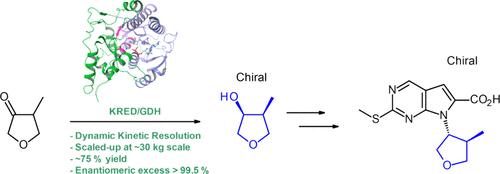Chemical and Biochemical Approaches to an Enantiomerically Pure 3,4-Disubstituted Tetrahydrofuran Derivative at a Multikilogram Scale: The Power of KRED
IF 3.5
3区 化学
Q2 CHEMISTRY, APPLIED
引用次数: 0
Abstract
A scalable synthesis of (3S,4S)-4-methyltetrahydrofuran-3-ol involving a keto reductase-mediated enantio- and diastereoselective reduction of a racemic ketone substrate is reported. This chiral intermediate was initially produced using a low-yielding three-step synthesis from ketone, deemed not usable for future batches. Looking for a scalable and environmental process: an eco-design approach led to a one-step, highly enantio- and diastereoselective biocatalytic reduction of the ketone to the targeted intermediate (3S,4S)-4-methyltetrahydrofuran-3-ol. In addition, the reaction operates via dynamic kinetic resolution under unprecedented mild conditions of temperature and pH, allowing for a full conversion of the ketone substrate into the desired enantiomer. The new route led to a significant improvement of all the key performance indicators, including PMI, solvent, and waste.

以化学和生物化学方法制备千克级对映体纯度的 3,4-二取代四氢呋喃衍生物:KRED 的力量
报告了一种可扩展的 (3S,4S)-4-甲基四氢呋喃-3-醇合成方法,该方法涉及酮还原酶介导的外消旋酮底物的对映和非对映选择性还原。这种手性中间体最初是通过低产率的三步合成法从酮中生产出来的,被认为不能用于今后的批量生产。为了寻找一种可扩展的环保工艺:采用生态设计方法,一步法、高对映和非对映选择性生物催化还原酮到目标中间体 (3S,4S)-4-甲基四氢呋喃-3-醇。此外,该反应在前所未有的温和温度和 pH 值条件下,通过动态动力学解析进行操作,使酮底物完全转化为所需的对映体。新路线显著改善了所有关键性能指标,包括 PMI、溶剂和废物。
本文章由计算机程序翻译,如有差异,请以英文原文为准。
求助全文
约1分钟内获得全文
求助全文
来源期刊
CiteScore
6.90
自引率
14.70%
发文量
251
审稿时长
2 months
期刊介绍:
The journal Organic Process Research & Development serves as a communication tool between industrial chemists and chemists working in universities and research institutes. As such, it reports original work from the broad field of industrial process chemistry but also presents academic results that are relevant, or potentially relevant, to industrial applications. Process chemistry is the science that enables the safe, environmentally benign and ultimately economical manufacturing of organic compounds that are required in larger amounts to help address the needs of society. Consequently, the Journal encompasses every aspect of organic chemistry, including all aspects of catalysis, synthetic methodology development and synthetic strategy exploration, but also includes aspects from analytical and solid-state chemistry and chemical engineering, such as work-up tools,process safety, or flow-chemistry. The goal of development and optimization of chemical reactions and processes is their transfer to a larger scale; original work describing such studies and the actual implementation on scale is highly relevant to the journal. However, studies on new developments from either industry, research institutes or academia that have not yet been demonstrated on scale, but where an industrial utility can be expected and where the study has addressed important prerequisites for a scale-up and has given confidence into the reliability and practicality of the chemistry, also serve the mission of OPR&D as a communication tool between the different contributors to the field.

 求助内容:
求助内容: 应助结果提醒方式:
应助结果提醒方式:


